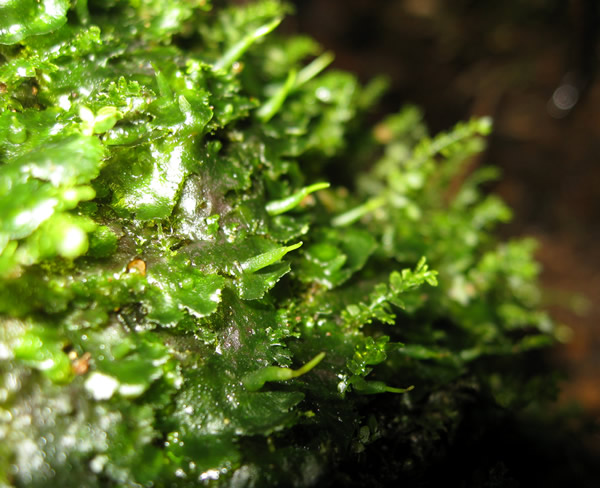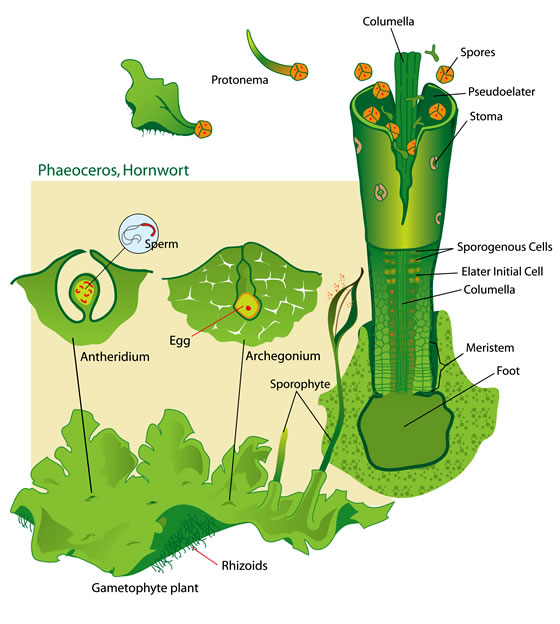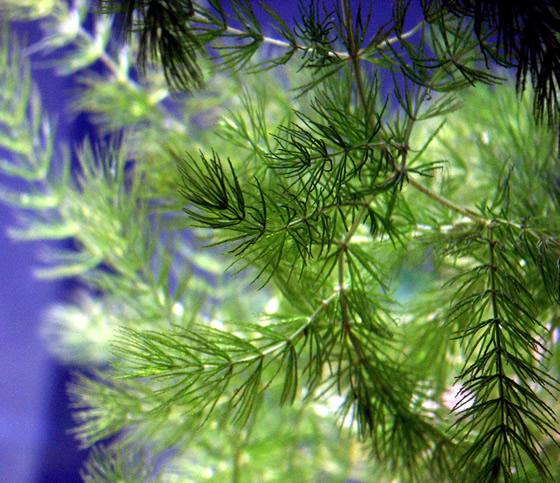 |
| Hornworts |
Hornworts are small, short, nonflowering, nonvascular plants which live both on land and in water. They represent an early land plant group and belong to three hundred species in the order Bryophyta. Related to mosses and liverworts, hornworts are sometimes called horned liverworts.
Evolutionary biologists have found a few fossils that could be the first known hornwort specimens. Fossilized spores dating from the late Cretaceous period, about 100 million years ago, are considered to be from hornworts.
Other fossils dated earlier in that period resemble hornworts but might actually have been liverworts. Spores from the Miocene epoch, approximately twenty-six million years ago, are the most common hornwort fossils.
  |
Botanists theorize that hornworts first appeared with earliest land plants prior to the Devonian period, 395 million years ago, and that fossil evidence is limited because the plants were so fragile. Many taxonomists consider hornworts to be more primitive than mosses and not as closely related to those plants as previously classified. A separate phylum, Anthocerophyta, was designated for hornworts, to separate them from mosses and liverworts.
A common and widely distributed plant, hornworts are blue-green members of six genera in two families, Notothylales and Anthocerotales, in the class Anthocerotopsida, derived from Greek words meaning “horn flower.” Sometimes hornworts are classified in the subclass Anthocerotidae of the class Hepaticae as horned liverworts.
Found globally, usually in moist, shady, and sometimes rocky environments, most hornworts belong to the genus Anthoceros. Species in the genera Dendroceros and Megaceros live primarily in tropical regions.
Hornworts are found in forests, fields, ponds, streams, and riverbanks in small clumps or large patches and sometimes grow on tree trunks. They are nonvascular and do not have vessels to transport nourishment and moisture.
In 1989 scientists reported they had detected a chemical compound with a structural and antimicrobial function in a hornworts species which was also found in the alga Coleochaete. This discovery suggested that green algae and hornworts were more closely related than previously thought.
Life Cycle
 |
| Hornwort life cycle |
Hornworts’ reproductive cycle occurs in an alternation of generations, in which a gametophyte creates a plant body (thallus) in the sexual generation, and the sporophyte produces a spore containing capsule in the asexual generation. In the sexual generation, hornworts’ gametophytes are flat and as small as 1 to 2 centimeters (0.4 to 0.8 inch) in diameter.
The thallus has hornworts’ sexual organs, the male antheridium and female archegonium, on its top surface (whether the male and female organs occur on the same plant varies by species) and rhizoids on the bottom, which secure plants to soils.
The hornworts’ gametophytes resemble a clump of small leaves. Occasionally, the cyanobacteria Nostoc can be found in holes in the thallus, where it fixes nitrogen to exchange for carbohydrates. Hornworts differ from liverworts in that hornworts lack cellular oil bodies and have mucilage instead of air chambers.
During the asexual generation, the sporophyte relies on the gametophyte for food and moisture, remaining connected to it during its life. Water is essential for the transport of sperm from the antheridium to the archegonium, where fertilized eggs become sporangia.
   |
From a basal sheath on the thallus, the sporophyte creates a slender, hornlike cylinder, which can be as high as 12 centimeters (4.75 inches) and gives the hornwort its common name.
Filled with spores, the sporangium elongates and gradually splits open from top to base, scattering spores. Internally, horn tissue continues to divide to produce thousands of spores. Other cells, called pseudoelaters, help spread spores, which germinate to begin the cycle again. Hornwort spores can survive as long as one decade in soil. Hornwort reproduction can also be achieved vegetatively if the thallus is fragmented.
Physically, hornworts resemble liverworts. They subtly differ from liverworts by having a place on the sporophyte’s base, a near-basal meristem, where cells continue to divide and grow during the sporophyte’s life. Hornworts also have a tissue column on the capsule, called a columella.
Hornwort gametophytes can be differentiated from those of liverworts and ferns by examination under a microscope to detect one large chloroplast in each hornwort cell. This chloroplast sometimes surrounds the nucleus and contributes to the color and translucency of hornworts.
Magnification also reveals the mucilage between cells, instead of air, where cyanobacteria thrive. Hornwort sporophytes also deviate from those found in mosses and liverworts because they exist even after the gametophyte dies.
Taxonomy
In the late 1990’s some botanists, deviating from the Linnean system, pursued new classification methodology in which molecular data was used to evaluate plants’ taxonomical descriptions. This evidence was used to investigate and hypothesize about the origins and diversification of land plants.
Such studies led some scientists to theorize that although hornworts, liverworts, and mosses physically resemble and grow near one another, liverworts and mosses are more closely related to each other than they are related to hornworts and should
 |
| Underwater hornworts |
be assigned to different divisions. Plant evolutionary biologists seek to determine terrestrial plants’ primary lineages and phylogenetic relationships to one another. Botanists are especially interested in howthe three bryophyte groups are genetically connected and their relationships to land plant lineages.
Scientists disagree on whether hornworts or liverworts comprise land plants’ sister group and whether mosses and liverworts are descended from the same lineage. Researchers want to determine which plant is the most primitive and whether one group is an ancestor of the others.
Based on phylogenetic studies, botanists have developed hypotheses regarding hornworts. They suggest that hornworts are bryophytes derived from the earliest land plant lineages and that hornworts have developed specializations which differentiate them from other bryophytes and terrestrial plants.
In the early 1980’s B. D. Mishler and S. P. Churchill presented phylogenetic treeswhich placed the three bryophyte lineages in the sequence of liverworts, hornworts, and mosses at the base of land plants, indicating that liverworts are a sister group to all land plants, and mosses are the vascular plants’ sister group. Although many botanists accepted this interpretation, others developed dissenting theories.
David J. Garbary and his colleagues examined male gametogenesis in the sperm of bryophytes, which share similar development characteristics. They determined that bryophytes collectively are a sister group to vascular plants and that mosses and liverworts are more closely related to each other than to hornworts.
Additional molecular sequence analysis of morphological characteristics reinforces the concept that hornworts are the basal lineage for terrestrial plants and that mosses and liverworts are the monophyletic sister group to vascular plants.
Other botanists are convinced by molecular examination of chloroplast genetic sequences that hornworts are vascular plants’ sister group. Scientists continue to test theories to prove that hornworts represent the oldest surviving land plant lineage.
Uses
The name hornwort is also used to describe an aquatic flowering plant, Ceratophyllum demersum, often called the coontail, from the family Ceratophyllaceae. Usually considered a weed or herb, this plant hasmany rigid, toothed, horn-shaped leaves, produced in groups of five. Sometimes looking like a raccoon’s tail, it has no roots and lives beneath or floats upon the water surface, occasionally in colonies.
This plant can grow as long as 4.6 meters (15 feet) and has branches. For pollination, both tiny male and female flowers are located on plants, which produce fruits with seeds. Most reproduction occurs vegetatively by plant fragments.
These hornworts are popular aquarium plants. Cuttings and shoots grow from placement of rhizoids in gravel-covered tank bottoms and quickly reachwater surfaces in thick clumps,which need to be thinned. These hornworts provide cover for fish fry and also oxygenate bodies of water in which they are submerged.